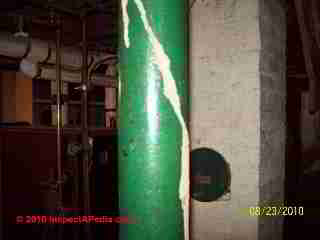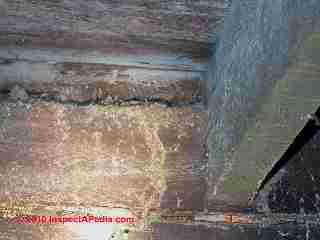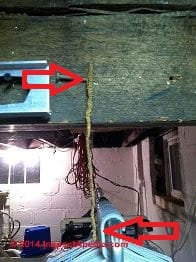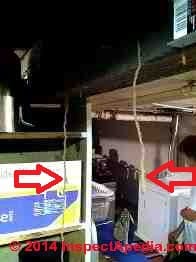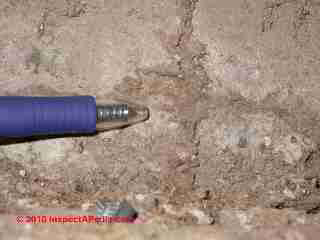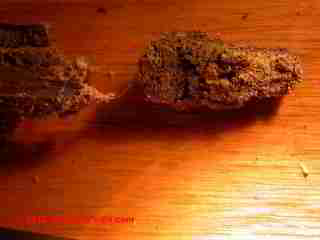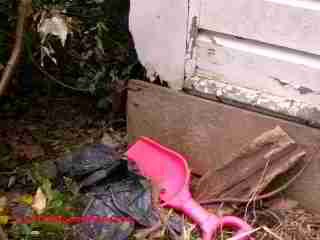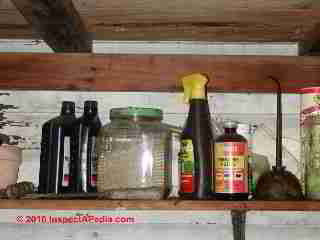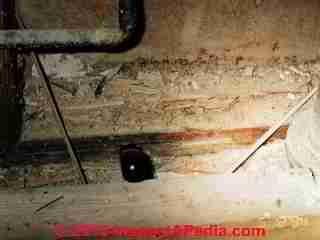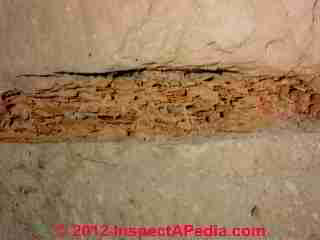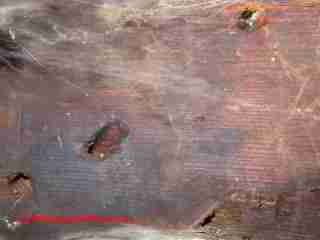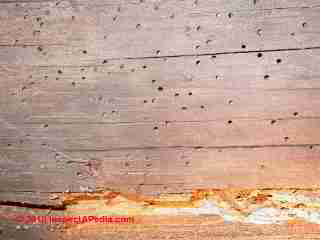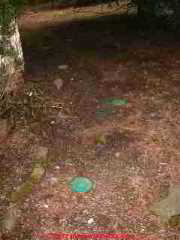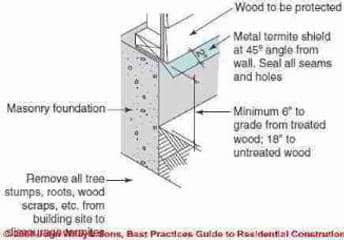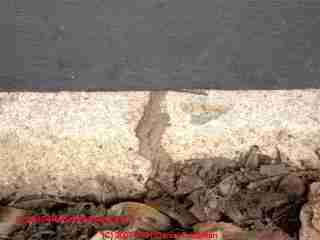 Termite Identification, Damage, Control
Termite Identification, Damage, Control
How to Detect, Evaluate and Prevent Structural Damage from Termites
- POST a QUESTION or COMMENT about termites & termite attacks on buildings: cause, effect, evaluation of extent of structural damage, termite treatments & prevention
Termites & termite damage inspection, treatment, prevention:
Termite information in depth, including termite inspection case reports, field photos and advice. This article discusses how to recognize termites & termite damage, & how to cure or prevent termite damage on buildings.
This article provides termite damage photographs, termite inspection advice, and lists additional articles that discuss the inspection, detection, prevention, and repair of structural damage from termites. We describe the use of termite control by bait traps, chemical poisons, and termite shields, and we include photos & warnings about amateur termite treatments.
Preventing these problems by good design and by building maintenance is preferred to simple chemical applications around a property. When use of pesticides is required, there are some important choices that we will discuss.
InspectAPedia tolerates no conflicts of interest. We have no relationship with advertisers, products, or services discussed at this website.
- Daniel Friedman, Publisher/Editor/Author - See WHO ARE WE?
How to Spot Termite Damage: Case Report of Un-Noticed Termite Activity
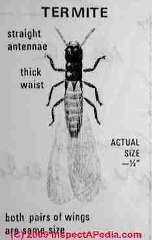
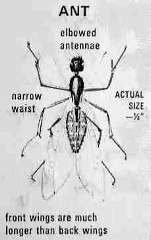 These sketches show how you can easily tell the difference betrween a winged (swarming) termite and a (winged) carpenter ant. This article discusses how we find and control termite attack or termite damage on buildings.
These sketches show how you can easily tell the difference betrween a winged (swarming) termite and a (winged) carpenter ant. This article discusses how we find and control termite attack or termite damage on buildings.
If your "flying ant" looks like the ant skecth above, see CARPENTER ANTS.
Article Contents
- AMATEUR TERMITE TREATMENT WARNINGS
- COMPARE TERMITE DAMAGE to POWDER POST BEETLE
- DESERT TERMITES
- DRYWOOD TERMITES
- TERMITE BAIT TRAPS
- TERMITE DAMAGE PHOTOGRAPHS
- TERMITE DAMAGE INDICATORS
- TERMITE INVITING CONSTRUCTION
- TERMITE MUD TUBES - separate article
- TERMITE SHIELDS
[Referring to the termite damage photos shown just below] I found this termite damage in a house yesterday. The shelter tubes were so large, they were hanging out of the wood. The termites have been in this house for many years, and this sign is that there is a large infestation that has caused sever damage to the house.
The main 10x12 center structural beam was so damaged, that about 3/4 of it will have to be replaced.
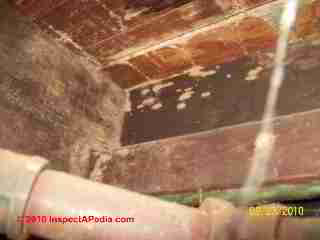
This is a significant structural issue with a house. If the homeowners had known what to look for, this may have been caught before the damage was so severe. As you can see form the cob webs, they rarely went there, and did not clean well, so the damage was missed until it was severe.
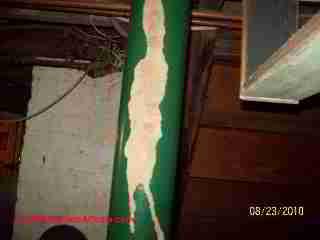
We provide a more lengthy case study of a termite inspection that found severe, covered-up and improperly-repaired termite damage
at TERMITE DAMAGE INSPECTION. There photographs show a sequence of clues leading to the discovery of the termite problem.
Termite Mud Tubes - Indicators of Termite Activity
Details about termite mud tubes, where they are found, what they look like and what they mean are now found
at TERMITE MUD TUBES. Excerpts from that article are just below
Our termite damage photograph at below left illustrates that carpenter ant activity (frass or loose "sawdust) may be found in the same location as termite activity (the mud tubes).
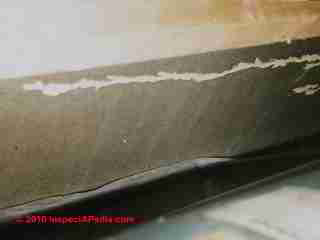
Our second termite mud tube photo (above right) is more clear and shows branching termite mud tubes running along the surface of a floor joist.
Reader Question: We noticed some hard stalagmite looking things (pictures attached) in our basement and we were wondering if these are from termites? - G.M. 8/3/2014
[Click to enlarge any image]
Reply:
I'm sorry to say yes, that looks like significant and active termite activity. The hanging mud tubes are the critters' exploration for another wood contact avenue besides the beam that they already infest.
Because those hanging mud tubes are quite fragile I infer from your photographs that either they are located in an area where no one has passed for some time or the termite activity is voracious.
More of these termite mud tube photos and our recommended actions are now found in this separate article:
TERMITE MUD TUBES
Termite Mud Tubes Outdoors
Details about termite mud tubes found outdoors are now found
at TERMITE MUD TUBES OUTDOORS. Excerpts are just below.
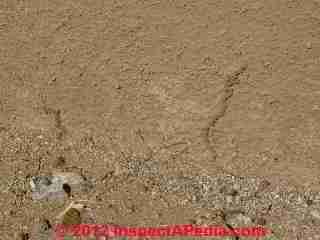
Termite mud tubes may appear on the outside (photo at left) or inside of building walls or other structural components (photo at left) or they may appear on the ground itself (below left).
These Arizona termite mud tube photos just below were contributed by our Arizona correspondent (and daughter) Mara Gieseke, Tucson AZ
Break Open Termite Mud Tubes?
Details about the effects of breaking or disturbing a termite mud tube are now found
at TERMITE MUD TUBES IF DISTURBED. Excerpts are just below.
Disturbing a termite mud tube is shown by my pen in the photo above. If you disturb a mud tube and termites fall out you know for sure you've found an active colony.
If you disturb a mud tube and don't see any termites, you'll need more information and probably a more expert inspection.
Termite Damage Indicators, Inspection Clues, Where to Look
At above left is a closeup photograph of "mud" extracted from termite damaged oak floor.
Our photograph at below left shows two signs that should tip off any inspector of a high risk of hidden insect damage: the wood siding is brought close to the ground, perhaps also at a building corner where a downspout or roof drainage spills. Water plus wood plus proximity to the ground surface add up to a high risk of insect attack.
Add the observation that an amateur-workmanship wood "skirt" was nailed against the bottom of the foundation, very possibly covering up damage, and this is a red flag for termite or carpenter ant attack.
Our second insect damage risk indicator is the photo below: a collection of pesticides, some of them perhaps old and no longer permitted for use by homeowners, found in the building is often a clue that termite or other insect poisoning or treatment was performed by someone other than a licensed pest control applicator - risking not only incompetent ineffective work, but possibly environmental contamination that can be a risk even to the building occupants.
We discuss the inspection and detection of severe termite damage in added detail
at TERMITE INSPECTION & DAMAGE ASSESSMENT
Building Features that Invite Termite Damage Tell Us Also Where to Look for Termite Attacks
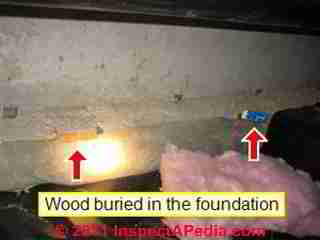 Do wood forms left between a footing and stem wall increase the risk of a termite attack
Do wood forms left between a footing and stem wall increase the risk of a termite attack
I have inspected new construction home last week. There were some 1x4 wood forms left in between of footing and stem wall.
(Left over footing forms) Is this creating structural or pest problems in future?
Please let me know if I need to do some actions before the house close. Thanks - T.N.
Reply: Yes in many instances. Best practice is to remove wood forms close to or in contact with the soil around a building. Don't leave wood buried around a building.
A competent onsite inspection by an expert usually finds additional clues that help accurately diagnose a problem including evidence of present or prior wood destroying activity at a building (termites, carpenter ants, powder post beetles, carpenter bees, other wood destroying insects (WDI)) or an experienced inspector can cite construction details that increase the risk of a termite or other WDI attack in the future.
That said, for your building and based on the photo you provided (above left) does not look too risky in that there is good visible access to the lower foundation wall to observe any future termite mud tubes or other signs of insect activity.
Watch out: there could be other termite-attack risk factors not shown in the photo at above-left. These details are discussed in the articles cited immediately below. Also I don't like seeing that insulation left on the crawl area floor.
Details about outdoor indicators of termite activity and construction details likely to invite termite attack on the building are found
Because insect damage on buildings is very often related to locations of water leaks or moisture traps, readers should also
Termite Damage Photographs Confirm Extent of Structural Damage

When observing termite damage such as in the wood framing members in our photo at below left, an expert will explore adjacent members (probing and visual inspection) as well as the infected members to discover the extent of damage.
Above our screwdriver has fully penetrated the sill plate at the bottom of an interior partition wall in a home where we found extensive termite damage.
And below in our second photo, our screwdriver penetrates the termite-infested wall stud between the sill and ceiling. [Click to enlarge any of our images.]
 ...
... 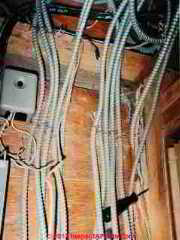
Wood destroying insects may enter a single wood member such as a floor joist and travel along just that member, or depending on site conditions and age of the WDI infestation, many structural members may be involved.
Photo Guide to Drywood Termites & Other Insects that attack wood structural components above ground and in dry climates
The photographs of drywood termites and termite damage shown here illustrate termite damage in the Southeastern U.S. (Old Tucson, AZ) and Central Mexico (San Miguel de Allende, GTO).
This severely damaged wood was caused by a type of "dry wood" termites that attacked a stucture we inspected in Tucson, AZ. This wood segment was a nailer set into an otherwise solid adobe structural wall.
Here we see an example of insect attack on a wood component that was not in ground contact and was not exposed to an unusual water source or leak.
Also see BRICK WALL WOOD NAILER INSERTS
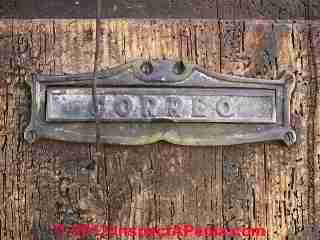
In the insect damage photo above we illustrate what we think is not termite damage but wood borer damage to an antique wood door, San Miguel de Allende, Guanajuato, Mexico. But as additional photos illustrate, termite damage is indeed also found in this location.
Some Termites do Not Attack Structures - Gnathamitermes tubiformans Desert Termites Photos
A local exterminator visited this site and identified the termites in our photographs above as Desert Surface Termites [or by some sources just "desert termites" or Gnathamitermes tubiformans.]
Gieseke passed on these details: desert surface termites, according to local exterminator Truly Nolen, are fatter than other types of termites.
They do not attack structures. If you were to leave a 2x6 piece of wood in the yard, they would cover it with their mud but they would not eat into it. They would just eat the very outer layer.
Bottom line: desert termites may not attack your building, but they may eat your plants.
Details are in DESERT TERMITES [PDF]
Gieseke's photos below show the mud tubes of Desert Surface Termites on the ground surface near Tucson AZ.
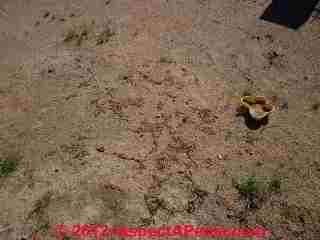
More about Desert Termites is provided at our references below.
In general, termites' natural home is in the soil where they attack wood below ground, coming up to higher wood found where there is convenient access, and, depending on the species, moisture.
Your termites are almost certainly subterranean termites as you are finding them living in the ground. (Drywood termites, unlike subterranean termites, do not require direct access to a moisture source and are often found attacking wood above ground level.)
Perhaps when you first disturbed the mud tubes on the ground, soil moisture had been so great (following recent rain in Tucson) that your local subterranean termites were coming to the ground surface.
In most of the U.S. only subterranean termites are found, but along the U.S. southern border (including southern Arizona) and further south, both drywood and subterranean termites may be found. In North america north of the U.S. termite damage is less common.
Drill Marks or Old Containers May Mean Amateur Termite or Other Insect Extermination Attempts that May be Unsafe
At left we illustrate a clue suggesting a do-it-yourself pesticide applicator may have been at work.
Below left our photograph shows homeowner-drilled holes in a building rim joist - perimeter framing. This do-it-yourself termite treatment involved drilling and spraying a termiticide or chemical onto and into the wood.
Because of the age of the home (1700's) and amateur work, we were concerned that Chlordane, a toxic, now banned termiticide may have been used as this chemical was previously available for easy purchase in home and garden centers.
Indeed, our test-cut sliver of test wood taken rom the rim joist was confirmed by a chemical test laboratory as having been soaked with Chlordane - a toxic chemical with a long half-life. The building needed further evaluation for the extent of chemical contamination in order to decide if remediation (removal or sealing of treated wood) would be needed.
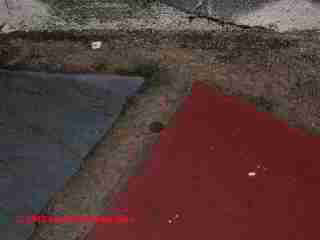
Our second termite treatment clue photograph (above right) shows a drill mark in a concrete and slate patio outside and abutting a home foundation wall.
Regularly spaced drill openings, 18" to 24" apart in a concrete basement floor slab set just inside the foundation wall, or around the outside of a foundation where sidewalks, driveways or patios are installed, are a likely indicator that a professional PCO has pumped a termiticide barrier around the building.
This means you will want to inspect the structure for prior termite damage in order to be sure that further repairs or treatment are not needed.
At Carpenter Bee Holes & Powder Post Beetle Holes we show other holes in wood that are made by insects but that are sometimes mistaken for electric drill holes.
See PESTICIDE EXPOSURE HAZARDS for details about the health hazards of exposure to pesticides used or applied indoors.
Comparing Termite Damage to Powder Post Beetle / Old House Borer Damage
Details about powder post beetles and old house borer insect damage on buildings are at POWDER POST BEETLES. Excerpts are below.
At DRILL MARKS we show drill marks in wood caused by an amateur pest treatment attempt. While to an experienced eye, holes in wood caused by insects are easily distinguished from those caused by humans using a drill or hammer and nail, on occasion someone is fooled.
Here we illustrate two cases of holes that are caused by insects, not mechanical events on buildings: powder post beetle holes in wood, and carpenter bee holes in wood.

In our powder post beetle photos above, while there was significant beam damage, the infestation did not appear active.
Powder post beetle damage is typically treated with a topical insecticide spray. Some pest control operators (PCOs) also spray paint the wood surfaces in order to make it easier to spot a renewal of insect activity in the future.
We look for the presence of fine wood powder around the insect exit holes or on the ground below the damaged infected member as indications of recent insect activity.
See POWDER POST BEETLES for details about this topic.
Termite Bait Traps as a Method for Termite Control
One method for stopping or avoiding termite attack on buildings involves the placement of termite bait traps around the building.
Our photo (below ) illustrates a termite bait trap set outside and close to a stone foundation wall.
Below we see termite bait traps spread at a typical interval around a building that had been subject to termite attack.
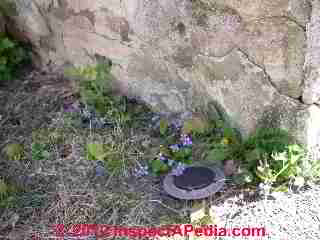
Watch out: don't assume that because there is a masonry block, brick, or stone foundation that a building is termite proof, even when there is good clearance between the soil top and wood framing. With sufficient invitation (leaks, water) termites find easy passages trough stone, concrete block and brick foundation walls to wood framed sills, rim joists, and floor structures above.
- The termite bait trap approach relies on regular trap inspection by the pest control operator.
- When termites are discovered attacking one of the tasty wooden bait stakes, the stake is replaced (by the PCO) with one containing a chemical intended to poison the termites.
- Some may not realize at first that the cost of this termite damage prevention system is more than the initial cost of installing the termite bait traps. The building owner needs to assure (and pay for) regular inspection and maintenance of the termite traps.
Watch out: If the termite bait trap system is not being regularly inspected, you have put out termite-attracting wood around the building perimeter without following through with the proper steps, and in our OPINION you may actually have increased the risk of a termite attack. Be sure your termite bait trap system is being inspected regularly.
If we see termite bait traps that are abandoned, overgrown, covered with leaves and debris we know that the traps are not being inspected regularly.
See TERMITE SHIELDS vs TERMITICIDE for details about comparing methods of preventing termite attack on buildings. Below are two photographs of termite bait traps to help you recognize termite bait traps when you see them. This approach avoids placing a chemical barrier around the building to stop or prevent termite attacks.

Guide to Use of Termite Shields on Building Foundations as a Termite Barrier
As discussed in Best Practices Guide to Residential Construction (Steve Bliss, J Wiley & Sons) :
Metal termite shields are widely used atop foundations in the southern United States and in tropical climates as a physical barrier to termites. They sit directly on top of foundation walls, piers, and other supports before the first piece of wood is installed (see Figure 1-3 at left).
At one time termite shields were thought to block the entry of subterranean termites, the most widespread and destructive wood-boring insect in the United States.
However, subterranean termites, which nest in the soil, will exploit the tiniest gaps in termite shields or other barriers to reach the wooden portions of a house and will build tunnels along exposed foundation walls and around termite shields if necessary.
Although the shields do not stop termites, they slow down their progress and force them to build their tunnels in the open where they can be easily seen during inspections.
To work at all, the termite shield must have tightly sealed joints and be sealed around foundation bolts and other penetrations. Joints can be either soldered or mechanically interlocking. If the barrier is unsealed, termites will find any small gaps and render the effort worthless.
Below our termite mud tube photos show that a termite shield appears to have been installed along most but not all of the building foundation top. Or was it? We don't know if this is wall flashing that leaves sills exposed just under the wall edge, or whether the flashing extends across the foundation to the interior (as recommended).
But our second termite photo (below right) shows a termite mud tube ascending the same foundation wall and passing under the termite shield. The shield makes it more difficult, but not impossible, for termites to attack a building.
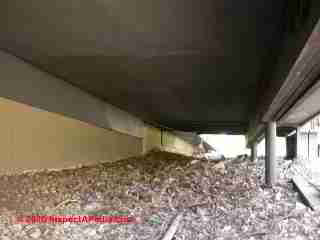
TERMITE SHIELDS vs TERMITICIDE gives a discussion of termite shields and insect attack on buildings using foam board foundation insulation.
More installation details for termite shields and other building flashing can be found
...
Reader Comments, Questions & Answers About The Article Above
Below you will find questions and answers previously posted on this page at its page bottom reader comment box.
Reader Q&A - also see RECOMMENDED ARTICLES & FAQs
by Angie - Can termites buid tunnels under a carpet
Can termites build tunnels in ur basement carpet and its like you can smell the dirt under the house a screwdriver will fit ynder the baseboards in the basement do they do all this
Reply by (mod) -
Angie
Termites might, in an extreme case, come up through a carpet, but more likely if you're seeing mud tubes the more serious problem is in the wood flooring, subflooring, and structure below. It sounds as if you need an onsite inspection by an experienced pest control official.
by shar - what's the spongy stuff between concrete driveway slabs? Termites?
In my driveway where the 4 slabs come together with some sort of spongy material....placed there to prevent cracks, I suppose. I came home one day to find, in scattered sections of the spongy stuff, it looked to have been dug out and dirt from below the slab scattered around the hole.
There were about 6 holes. Looked odd. I swept it and swept the dirt right back into the hole it came out of. I left this morning with it looking fine. I come home this evening and the scatter dirt and holes are there again..... Is it termites....
Reply by (mod) -
That is most likely an expansion joint or control joint, filled with caulk, or other material intended to allow for thermal movement between concrete drive slab sections to avoid cracking.
Question: small brown granules under the siding on the concrete
steve said:
My home is 2 yr old live in wisconsin where tge concrete porch butts up to the frame of the house i am finding small brown granuals directly under the external siding on the concrete looks like dirt but uniform insize any ideas
Reply:
Steve, look for ant activity near the foundation wall.
Question: our ceiling began a popping noise, could that be due to insects
About 4 months ago our ceiling began popping, every day, usually after 12:00 noon. The house is 14 years old and we have never had this problem before. The worse part appears to be in the greatroom where the ceiling butts up against insulation and the roof. We have not experienced any cracks in the drywall.
Do you know if insects can cause this type of problem. We live in Northwest Ohio where we had the hottest, driest summer in over 100 years. It seems to stop late at night. I am home during the day and the sound moves randomly around the room. I do not know where to turn. Can you possibly advise? (Sept 13, 2011) Nina Claire said:
Reply:
Nina if there is no evidence of insect attack on the building, and considering the temperature extremes you describe, I'd start addressing this ceiling popping noise with this
article:
TRUSS UPLIFT, ROOF that may explain what's going on.If on the other hand, your inspection of the roof or ceiling structure found extremen rot or insect damage (risking a dangerous collapse) that would be an urgent problem needing temporary support, strutural repairs, etc. One would think that before things got that extreme you'd see roof leak stains, ceiling sagging, drywall cracks, tears, wall/ceiling separation or similar clues.
Question: can I pull down insulation, treat for powder post beetles, then re-use the insulation?
I need to pull down existing paperbacked fiberglass insulation from unfinished basement ceiling to treat joists & underfloor for powderpost beetles.
Can i put the same insulation back up afterwards? or would the insulation contain the beetles, or doesnt it matter because they eat the wood and it has been treated. i am getting exorbitant prices for replacing the insulation and would like to re-use what I am taking down. - (Dec 2, 2011) pam
Reply:
Pam: If you can keep the insulation batts intact and if you find that it is clean in appearance it is reasonable to re-install it. If the insulation is dirty or if it has been wet, I would replace it as you don't want to reinstall insulation that may be a reservoir of insect allergens or hidden mold. If you were seeing exorbitant prices to replace insulation, most of that cost may be the labor.
Buying new insulation itself, at any home supplier or building supplier, should be quite reasonable. For example, you can buy a roll of Owens Corning EcoTouch 15"W x 39ft R19 Fiberglass Insulation (RU40) for around $30. per roll.
Question: something tiny is boring through our ceilings
At my Dad's house there is something very, very tiny boring through the ceiling. He just swatted it away, but this morning is saw another one coming out of the same hole. I got it and it may be some kind of termite, but it's so tiny I had to get a magnifying glass to see it. The hole is perfectly round. There are two holes in the ceiling. Do you think it is a termite? - Anonymous - (Nov 20, 2012)
Reply:
can't say from just your description if you saw a termite, but in general you would never see a termite voluntarily coming out into building air - they need to be protected from light and to low humidity - which is why they build mud tubes to cross between building materials or surfaces.
It might be smart to call an exterminator - let us know what you find.
Question: do termites fall out of trees onto a roof? Termite resistance of metal roofing?
We have limbs of trees hanging over the roof of our house. We've been told that termites can fall out of the tree and cause harm to our house. What if it is a tin roof.? - Edward
Reply:
Thanks for the question Edward.
What you were told is inaccurate. While I have, though rarely, found termites in a building's roof structure, they entered from the ground level, not from overhanging trees, and certainly not from live trees. Termites infest dead wood not live wood.
In some climates, "drywood" termites will indeed attack structural components that are above-ground and not in direct soil contact.
In more temperate or humid climates where trees are more likely to be overhanging a building, termites will most often enter a building through soil around the structure, finding a passage through wood in contact with or close to the soil.
While I agree that a metal roof, intact and not leaking, would be resistant to insect attack from above, that's not just because insects would find boring through metal tough going. Insects don't generally bore through asphalt shingles, nor rubber roofing either. Rather, an intact metal roof should mean that water is not penetrating the roof structure. A dry building is much less inviting to wood destroying insects.
Watch out: while termites don't climb up trees and leap gloriously through the air onto your house roof nor any other roof, carpenter ants do enjoy that activity. While carpenter ants too prefer wood close to soil as an invasion pathway into a building, unlike termites carpenter ants are perfectly happy wandering around in the open, including exploring live trees and occasionally falling off, jumping off, or blowing off of such trees onto a building surface.
But if carpenter ants invade a roof, it's not because they were skydiving onto it from a tree so much as because there is a leak in the roof that has made occupying it attractive to the carpenter ants.
Finally, you should indeed trim back tree limbs overhanging and close to the roof surface, to reduce the accumulation of leaves and debris that can damage the roof or clog its gutters.
At STAIN DIAGNOSIS on ROOFS we describe how to trim back trees or tree limbs overhanging a roof.
Question: how much structural damage might termites have done?
i'm selling my parents house, upon inspection, termite damage was found in the attic/roof. If termite damage is found in the attic/ roof beams how much structual damage may have been done? I was told that The price of the house should go down considerably. - (Sept 2, 2014) barbarjf@aol.com
Reply:
Barbara
Termite damage may be extensive, especially if these are termites that entered the attic structure by working their way up from ground level. Dry wood termites on the other hand can attack a building directly at higher points.
Before lowering the price of the house based on arm-waving and posssibly self-serving speculation, I'd suggest obtaining an expert and thorough damage assessment inspection and estimates of the repair cost. That data can be factored into the price of the home when it's sold.
Question: termite mud tubes on bathroom ceiling
We found termite tubes in ceiling of bathroom. How long did it take for termites to be there before the visible eye could see this damage. We thought we had a leak but found out it was termites. Could they have just gotten to our house in August and we found this end of October? Or would they have been there longer to do this? 11/19/2014 Nicki
Reply:
Nicki, in my experience, by the time you see stalactites of mud tubes hanging down from a ceiling or for that matter termits in the framing of a building ceiling the termite damage may be fairly extensive.
That's because termites generally enter a wood framed structure from the ground. To get into a ceiling the little fellows had to infest building wall sill plates, vertical wall studs, the top plate, and then find an attractive path into horizontal ceiling joists.
However a lot depends on what invited termites into a structure in the first place. For example, I've sometimes found termite damage limited in scope because of the very narrow and specific area of water leakage in a building and/or because some framing members were more inviting than others.
Some demolition - removal of ceiling materials and possibly other surface coverings on walls - will be appropriate to evaluate the extent of damage. You need help from an experienced termite inspector who will combine visual inspection with judicious probing to give advice on the scope of infestation and nature of treatment needed.
Depending on how much wood framing has been termite-damaged your building may need structural repairs.
...
Continue reading at TERMITE DAMAGE MUD TUBES or select a topic from the closely-related articles below, or see the complete ARTICLE INDEX.
Or see these
Recommended Articles
- CARPENTER ANTS
- CARPENTER BEES
- INSECT INFESTATION / DAMAGE - home
- PESTICIDE EXPOSURE HAZARDS
- POWDER POST BEETLES
- ROT, FUNGUS, TERMITES
- ROT, TIMBER FRAME - assess the extent of wood timber rot or insect damage
- ROT TYPES, BROWN SOFT WHITE
- TERMITE DAMAGE INSPECTION
- TERMITE IDENTIFICATION & CONTROL
- TERMITES & NAPTHALENE HAZARDS
- TERMITE SHIELDS vs TERMITICIDE
- VINES & SHRUBS on BUILDING WALLS, CHIMNEYS
- WOOD FLOOR, INSECT DAMAGE
- WOOD STRUCTURE ASSESSMENT
Suggested citation for this web page
TERMITE IDENTIFICATION & CONTROL at InspectApedia.com - online encyclopedia of building & environmental inspection, testing, diagnosis, repair, & problem prevention advice.
Or see this
INDEX to RELATED ARTICLES: ARTICLE INDEX to INSECT DAMAGE
Or use the SEARCH BOX found below to Ask a Question or Search InspectApedia
Ask a Question or Search InspectApedia
Try the search box just below, or if you prefer, post a question or comment in the Comments box below and we will respond promptly.
Search the InspectApedia website
Note: appearance of your Comment below may be delayed: if your comment contains an image, photograph, web link, or text that looks to the software as if it might be a web link, your posting will appear after it has been approved by a moderator. Apologies for the delay.
Only one image can be added per comment but you can post as many comments, and therefore images, as you like.
You will not receive a notification when a response to your question has been posted.
Please bookmark this page to make it easy for you to check back for our response.
IF above you see "Comment Form is loading comments..." then COMMENT BOX - countable.ca / bawkbox.com IS NOT WORKING.
In any case you are welcome to send an email directly to us at InspectApedia.com at editor@inspectApedia.com
We'll reply to you directly. Please help us help you by noting, in your email, the URL of the InspectApedia page where you wanted to comment.
Citations & References
In addition to any citations in the article above, a full list is available on request.
- David Grudzinski, Advantage Home Inspections, ASHI cert # 249089, HUD cert# H-145, is a professional home inspector who contributes on various topics including structural matters. Mr. Grudzinski, Cranston RI serving both Rhode Island and Eastern Connecticut can be reached at 401-935-6547 fax- 401-490-0607 or by email to Davidgrudzinski@aol.com. Mr. Grudzinski is a regular contributor to InspectAPedia.com
- Fuchs, Thomas, W., DESERT TERMITES [PDF] Thomas W. Fuchs, Extension Entomologist, Darrell N. Ueckert, Texas Agricultural Experiment Station, and Bastiaan M. Drees, Extension Entomologist, Texas Agricultural Extension Service, Texas A&M University System, web search 09/13/2010, original source: http://insects.tamu.edu/extension/bulletins/uc/uc-016.html
- Termite Damage Case Study#1 - exterior clues predicted insect damage; interior access was limited but certain clear clues led right to the damage as well as an attempted cover-up of termite damage below a "repaired" wooden floor. The real evidence was in the driveway. [in process]
- Termite Damage Case Study#2 - very limited visual access inside a building made this inspection for structural damage tough. Outside conditions suggested a risk of water entry and insect attack. Inside the house had mysteriously sloping floors - sloping in every direction. There were few indications of ongoing building movement to explain the sloping. Perseverance led to finding severe termite damage at the building sills.
- Termites, Wikipedia web search 09/11/2010, original source: http://en.wikipedia.org/wiki/Termite provided some information about termite size.
- Truly Nolen Pest Control, Tel: 866-221-4765, Web: http://www.trulynolen.com/ is a national franchise of pest control operators in the U.S. Quoting from the company's website:
Truly Nolen [has] over 80 offices located in Arizona, California, Florida, Nevada, New Mexico, Texas and Utah. - U.S. EPA, TERMITES, GREENHOUSE GASES, U.S. EPA, Environmental Protection Agency. Web search 09/11/2010, original source: http://www.epa.gov/ttn/chief/ap42/ch14/final/c14s02.pdf Quoting an interesting passage from this brief document:
Termites inhabit many different ecological regions, but they are concentrated primarily in tropical grasslands and forests. Symbiotic micro-organisms in the digestive tracts of termites (flagellate protozoa in lower termites and bacteria in higher termites) produce methane (CH4).
Estimates of the contribution to the global budget of CH4 from termites vary widely, from negligible up to 15 percent.
- U.S. EPA. Prevention, Pesticides, and Toxic Substances. 1997. Re registration eligibility decision: Diflubenzuron. Pp. 17, 46. www.epa.gov/ pesticides.
- U.S. EPA. Office of Prevention, Pesticides and Toxic Substances. 1994. Pesticide fact sheet: Hexaflumuron. Washington, D.C.
- U.S. EPA. Office of Pesticide Programs. 2003.
Pesticide ecotoxicity database. Unpublished database.
U.S. EPA. Prevention, Pesticides, and Toxic Substances. 1998. Re registration eligibility decision: Hydramethylnon. Pp. 16-18, 43. www.epa.gov/pesticides. - U.S. EPA. Prevention, Pesticides and Toxic Substances. Undated. New chemical New chemical fact sheet: Noviflumuron. Washington, D.C.
- NCAP, "Protecting Your Home from Subterranean Termite Damage", Journal of Pesticide Reform, Fall 2004, V 24 No. 3, - 6-7, Northwest Coalition for Alternatives to Pesticides/NCAP, POB 1393, Eugene OR, 97440 541-344-5044 www.pesticide.org: Web search 09/11/2010: http://www.hipspro.com/pubs/subterraneantermites.pdf
This document discusses alternatives for termite protection including reducing the attractiveness of the structure to termites (get wood away from the building, fix leaks), use of 16-grit sand (diameter 0.06 - 0.1 in) as a termite barrier 18" wide x 3" deep in crawl areas, or stainless steel mesh for the same purpose under foundations and slabs, boric acid, Diflubenzuron (insect growth regulator, risk genetic damage, EPA classed as carcinogen), Hexaflumuron (insect growth regulator, EPA didn't ID health concerns, waived some testing, partly because of anticipated very low risk of human exposure), Hydramethylnon (stomach toxicant, EPA: Carcinogen, highly toxic to fish), Noviflumuron (chemically similar to hexaflumuron), can cause anemia, EPA didn't ID other health hazards, some testing requirements waived, moderately toxic to fish). - In addition to citations & references found in this article, see the research citations given at the end of the related articles found at our suggested
CONTINUE READING or RECOMMENDED ARTICLES.
- Carson, Dunlop & Associates Ltd., 120 Carlton Street Suite 407, Toronto ON M5A 4K2. Tel: (416) 964-9415 1-800-268-7070 Email: info@carsondunlop.com. Alan Carson is a past president of ASHI, the American Society of Home Inspectors.
Thanks to Alan Carson and Bob Dunlop, for permission for InspectAPedia to use text excerpts from The HOME REFERENCE BOOK - the Encyclopedia of Homes and to use illustrations from The ILLUSTRATED HOME .
Carson Dunlop Associates provides extensive home inspection education and report writing material. In gratitude we provide links to tsome Carson Dunlop Associates products and services.



